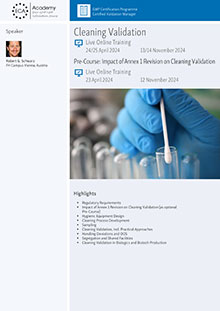FDA Perspective on Risk Management and its Influence on Quality - Inspection Deficiencies 2015

Recommendation
23-25 April 2024
In the framework of a conference on Quality and Manufacturing, David J. Jaworski, Senior Policy Advisor of CDER's Office of Manufacturing and Product Quality gave a presentation on risk management and its influence on quality. The slides of his presentation are now freely available.
The presentation starts quoting Theodore Roosevelt: "Risk is like fire: If controlled it will help you; if uncontrolled it will rise up and destroy you" - and Trevor Levine: "Risk Management is about people and processes and not about models and technology."
Then, he carried on stating the most frequent inspection deficiencies in 2015:
- 21 CFR 211.22(d): Quality Unit responsibilities
- 21 CFR 211.160(b): Laboratory controls
- 21 CFR 211.192: Investigation failures
- 21 CFR 211.113(b): Microbiological controls
- 21 CFR 211.100(a): Production process
- 21 CFR 211.42(c)(19(iv): Environmental monitoring
- 21 CFR 211.68(a): Electronic equipment controls
Under the title "Risk Reduction is Hard Work", he gave three examples:
The first example deals with tablet blend uniformity which has been improved by replacing direct pressing through wet granulation. Besides, the process had been continuously operated and assisted by Process Analytical Technologies (PAT) applications.
The second example concentrates on sterile production focussed on microbiological risks and human intervention. For Jaworski, the difference between a classical cleanroom and a Restricted Access Barrier Systems (RABS) is that - through human intervention in the laminar flow - classical cleanrooms are subject to higher risks than RABS. According to him, completely encapsulated systems present the lowest risks.
Finally, the third example on manufacturing documentation shows how electronic systems - provided they are well designed - can help reducing risks and errors. For Jaworski, it is a general problem that SOPs and batch documentation are often written in a not very user-friendly way by the scientists. Partially, employees even require SOPs to be able to fulfil batch documents at all. Yet, even if the paper document is well designed, the risk of erroneous entries still remains. According to Jaworski, the change to an electronic system doesn't always reduce the risk of erroneous entries because when badly designed batch documentation is duplicated into an electronic version, the document is and remains a badly designed document with the same risks of errors. For Jaworski, an electronic system which ideally leads the employee through the entire manufacturing process and only requires a few manual entries could help strongly minimising risks.
In a perfect world, such a system would also perform error checks.
For more detailed information please also see the slides of the presentation entitled "Managing Risk to Quality: The Good and the Bad"
Related GMP News
GMP Conferences by Topics
- General Quality Assurance and GMP Compliance Topics
- Hygiene
- General Microbiology Topics
- Regulatory Affairs
- Development
- General Analytics Topics
- Good Distribution Practice
- Sterile Manufacturing
- Computer Validation
- General Qualification/Validation Topics
- General Engineering Topics
- APIs/Excipients
- GMP Basic Training Courses
- Medical Devices and Combination Products
- Packaging and Packaging Material
- Data Integrity
- Qualified Person (QP)
- GMP Auditing
- Documentation
- Cleaning Validation
- General IT Compliance Topics
- Impurities
- OOS / OOE / OOT
- Material Testing
- Validation of Analytical Methods
- Analytical Instrument Qualification
- Stability Testing
- Microbiological Testing
- Technology
- General Manufacturing Topics
- Solid Dosage Forms/Semi-Solid Dosage Forms
- Biotechnology/Blood/ATMP
- Herbal Drug Products/Cannabis/Radiopharmaceuticals
- Others



